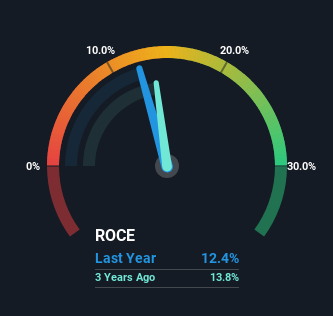Returns On Capital Signal Tricky Times Ahead For Manomay Tex India (NSE:MANOMAY)
What trends should we look for it we want to identify stocks that can multiply in value over the long term? Firstly, we'd want to identify a growing return on capital employed (ROCE) and then alongside that, an ever-increasing base of capital employed. If you see this, it typically means it's a company with a great business model and plenty of profitable reinvestment opportunities. However, after briefly looking over the numbers, we don't think Manomay Tex India (NSE:MANOMAY) has the makings of a multi-bagger going forward, but let's have a look at why that may be.
What Is Return On Capital Employed (ROCE)?
For those that aren't sure what ROCE is, it measures the amount of pre-tax profits a company can generate from the capital employed in its business. Analysts use this formula to calculate it for Manomay Tex India:
Return on Capital Employed = Earnings Before Interest and Tax (EBIT) ÷ (Total Assets - Current Liabilities)
0.12 = ₹404m ÷ (₹5.8b - ₹2.6b) (Based on the trailing twelve months to June 2024).
Therefore, Manomay Tex India has an ROCE of 12%. That's a relatively normal return on capital, and it's around the 11% generated by the Luxury industry.
Check out our latest analysis for Manomay Tex India

While the past is not representative of the future, it can be helpful to know how a company has performed historically, which is why we have this chart above. If you're interested in investigating Manomay Tex India's past further, check out this free graph covering Manomay Tex India's past earnings, revenue and cash flow.
How Are Returns Trending?
When we looked at the ROCE trend at Manomay Tex India, we didn't gain much confidence. To be more specific, ROCE has fallen from 16% over the last five years. However it looks like Manomay Tex India might be reinvesting for long term growth because while capital employed has increased, the company's sales haven't changed much in the last 12 months. It may take some time before the company starts to see any change in earnings from these investments.
Another thing to note, Manomay Tex India has a high ratio of current liabilities to total assets of 44%. This can bring about some risks because the company is basically operating with a rather large reliance on its suppliers or other sorts of short-term creditors. While it's not necessarily a bad thing, it can be beneficial if this ratio is lower.
The Key Takeaway
Bringing it all together, while we're somewhat encouraged by Manomay Tex India's reinvestment in its own business, we're aware that returns are shrinking. Yet to long term shareholders the stock has gifted them an incredible 103% return in the last year, so the market appears to be rosy about its future. Ultimately, if the underlying trends persist, we wouldn't hold our breath on it being a multi-bagger going forward.
Manomay Tex India does come with some risks though, we found 2 warning signs in our investment analysis, and 1 of those can't be ignored...
If you want to search for solid companies with great earnings, check out this free list of companies with good balance sheets and impressive returns on equity.
New: Manage All Your Stock Portfolios in One Place
We've created the ultimate portfolio companion for stock investors, and it's free.
• Connect an unlimited number of Portfolios and see your total in one currency
• Be alerted to new Warning Signs or Risks via email or mobile
• Track the Fair Value of your stocks
Have feedback on this article? Concerned about the content? Get in touch with us directly. Alternatively, email editorial-team (at) simplywallst.com.
This article by Simply Wall St is general in nature. We provide commentary based on historical data and analyst forecasts only using an unbiased methodology and our articles are not intended to be financial advice. It does not constitute a recommendation to buy or sell any stock, and does not take account of your objectives, or your financial situation. We aim to bring you long-term focused analysis driven by fundamental data. Note that our analysis may not factor in the latest price-sensitive company announcements or qualitative material. Simply Wall St has no position in any stocks mentioned.
About NSEI:MANOMAY
Manomay Tex India
Manufactures and sells denims and denim fabrics in India and internationally.
Proven track record with imperfect balance sheet.
Similar Companies
Market Insights
Community Narratives




